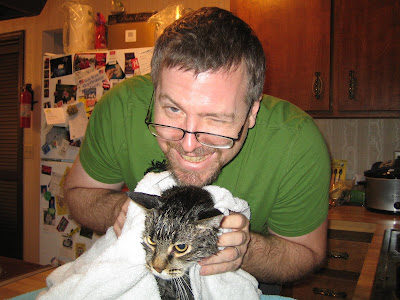AMBERGRIS = FLORIDA
Readers of my Ambergris stories who do not live in Florida, or who have only visited Florida's tourist attractions, often wonder how Florida could possibly have influenced me. In fact, the decay and proliferating fungi of Ambergris are elements also inherent to Florida. I live in Tallahassee, in the north of the state, about 45 minutes away, by car, from any hint of coastline. In the summers here, the humidity level hovers around 100 percent. The temperature is consistently 90 to 95 degrees F. The rain, for a couple of months at least, is near constant, and often ferocious. (A friend of ours from England told us that the first time he experienced Florida rain, he stopped his car from shock; he was used to the constant mist of England, not this torrential downpour.)
In such a climate, the rate of decay, the infiltration of insects, the appearance of fungi and lichen, are all accelerated. If our modern civilization stopped functioning for just four months during the summer--no pest control, no air conditioning, no lawnmowers--Florida would revert to a natural state far more swiftly than anyone might think.
We're in the heart of the summer now, and the vegetation around our house is defiantly green, richly green--one might almost say "verdant." The azalea bushes that surround our yard like a thick fence have long since bloomed, the watery fire of their blossoms snuffed out. The only colors now are greens and browns and white--the greens of grass, trees, and lichen; the brown of soil, of rotted twigs and branches, of tree trunks; the white of tiny mushrooms circling the decay. Our backyard has long been mostly compost pile, with a thick surface of brown leaves on top. Through this the mushrooms sometimes appear, like little sentinels. The half decomposed limbs of fallen branches are thick with lichen--a rich, green color that calls to mind the endpapers of old Victorian novels. The insects are everywhere, especially at night--great, awkward flying beetles like dreadnaughts, and tiny, ephemeral whispy things with legs like pencil lead, and moths like drab paupers circling the globe of our outdoor light. (Sometimes we see damselflies, more delicate than dragonflies, and unable to survive except at certain elevations, in certain types of humidity; they are black and shiny and velvety, but they move like drunken sailors.) Below the surface: earthworms, cockroaches rustling through the dead leaves. Above: thrashers, thrushes, wrens, blue jays, crows, and squirrels. At night, frogs will stick to the windows and we will watch their tiny pink-and-white throats shiver and pulse with life. At night, while you are trying to become the opposite of awake, you will hear the chorus of the frogs, which bark, and the chorus of the cicadas, which sound like tiny drills, and the chorus of the crickets, which sound as if they are trying to soothe both the frogs and cicadas to sleep.
We have one enormous, tall tree in the front yard. The biggest wisteria vine I have ever seen winds its way around the tree all the way to the top. I used to think that the tree and the wisteria were locked in decades-slow combat, a battle that might not end until long after I was dead. But lately I have begun to suspect that the tree and the wisteria are locked in an embrace. It is a decades-slow love story, which will reach its fruition long after I am dead.
When the wisteria blooms, it covers our cars, using the rain to stick to the doors, the roof, the windows, so that over time, if we are not careful, they are transformed into Mardi Gras floats. Their blossoms fall onto the grass and leaves. They become brown, shapeless, rotting into the ground, like everything else.
Ambergris is but a pale reflection of this...
JeffV



1 Comments:
Yea.. I Live In Florida And I Was Wondering Where This "Ambergris" Can Be Lcated In This Beautiful State I Live In Orlando But Have Fairly Good Knowlegde Of All The Surrounding Beaches.. Any Help Would be Apperciated...
Thanks Alot, Rich
Post a Comment
<< Home